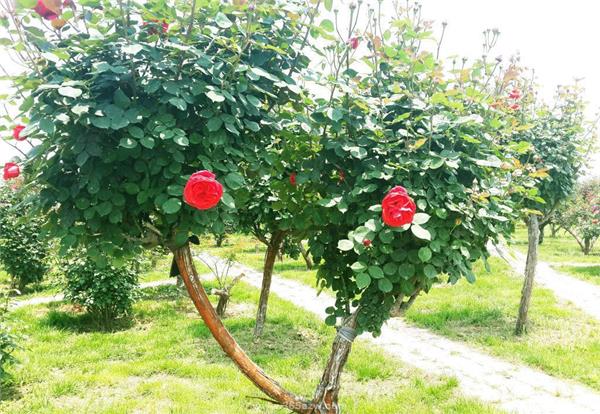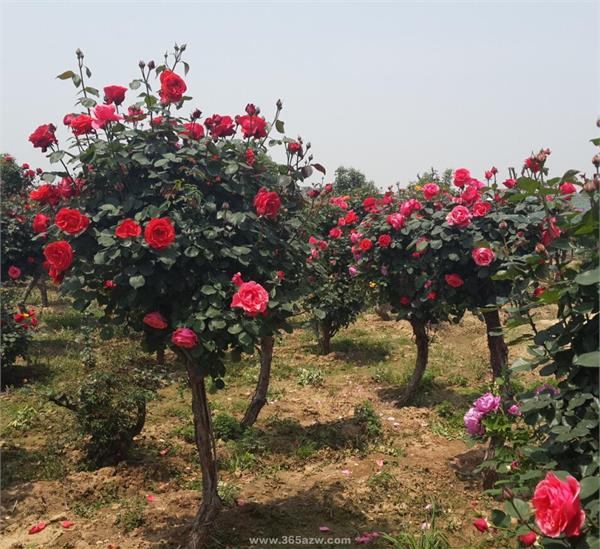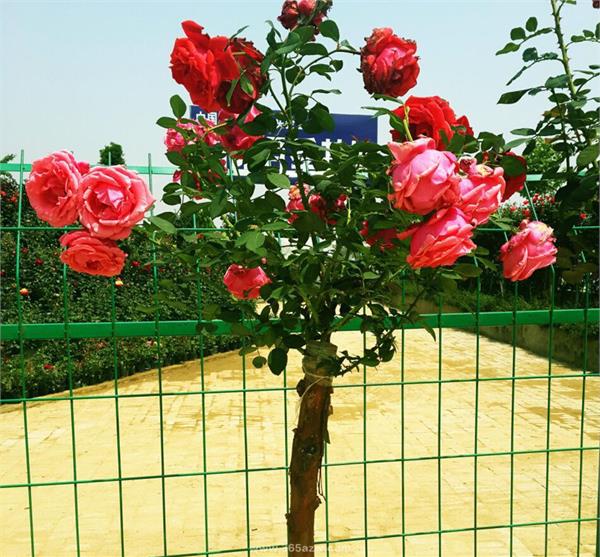Rose tree planting technology details
The traditional cultivation of rose trees takes 2 times of grafting, and it takes 3 years to form and come out of the nursery. Let's take a look at the details of the planting techniques of rose trees.

A detailed introduction to the planting techniques of rose trees
I. Establishment of nursery
If you want to breed rose trees quickly, you need to use double nurseries. One is the rootstock nursery and the other is the ear-picking nursery. What the two nurseries have in common is to choose flat, sunny, well-drained, moist, fertile, neutral slightly acidic soil with a PH value of 6 to 6.5. When ploughing, the base fertilizer per mu is applied according to the following formula: farm manure 5000 kg, phosphorus nitrate 20 kg, urea 10 kg, carbofuran granule 5 kg.
The rootstock nursery bed is 1.2 meters wide, and the rootstocks are planted in Baiyutang or Fentuan Rosa as rootstocks with a row spacing of 40 square meters, which are planted from May to July every year. After insertion, pay attention to seedling management, the Beginning of Winter will re-cut all the branches, leaving only one or two buds on the strong branches, the rest of the weak branches can be cut off by the root, and take appropriate measures to survive the winter. In the next spring, when the newly extracted branches reached 50 cm, only one strong branch was left in a rose, and all the rest were cut off. At this time, another topdressing is needed, and urea is applied 3 kg per 100 plants. And water it once with a flood of water. When the sturdy strip is 1.5 meters long, tie it with a thin bamboo pole to prevent tilting. At this time, you should hit the top, leave 3 buds after the upper bud, and remove all the other sprouting tillers. New sprouts should be eliminated in time. 7 to 10 days after topping, when the rootstock is easy to peel, it can be grafted.

The ear-picking nursery is 1 meter wide, and the large scented tea fragrance series and abundant flower rose series are selected and planted centrally. The row spacing of each plant was 30 cm. The varieties are listed to facilitate the selection of scions. And pay attention to seedling management. When grafting, the parts with strong branches and full spores should be selected for backup. In order to collect full buds as soon as possible, the following measures can be taken: first, remove rose buds, spray potassium dihydrogen phosphate on rose 5 days in advance, or sprinkle a small amount of urea and water 7 days in advance to facilitate bud formation. When taking buds, one should be mastered: generally, it is best to have half a grain of rice to be grafted.
2. Grafting method
There are many methods for grafting rose trees, and it is customary to use the "bud grafting method", which is simple, easy to operate, and has the characteristics of high survival rate. The specific operations are as follows:

Cut off the branches with flowers and leave 0.5 cm petiole. Squeeze the tip with the thumb and index finger of the left hand, with the petiole upward, at an angle of 45 degrees with the ground. Use the bud grafting knife to cut down 0.5 cm above the bud to the xylem, from shallow to deep, from deep to shallow after budding, and the incision is 2.5 to 3 cm long. The buds were removed from the branches. Gently pinch the petiole with the left hand, the xylem upward, and the right hand turn the skin a little under the bud to make the xylem warp up. As soon as the xylem is peeled off, the xylem is peeled off, and then quickly cut with a grafting knife in the smooth part of the rootstock about 1.4 meters high, depending on the size of the scion bud. Generally speaking, the knife edge is about 0.5 square meters long. Make a longitudinal cut down on one side of the incision. Be careful not to damage the xylem. Insert the tip of the knife from the intersection of ☆ and ☆, lift the skin, tear 2 cm down, leave 0.4 cm below, cut off the upper 1.6m skin, quickly put the buds into the cortex opened by the rootstock, stick closely to the xylem of the rootstock, retain the bud hole, and tighten the boundary with 20cm long and 0.7mm wide plastic strips.
III. Main points of grafting
Fast: first, the knife should be fast, generally about 200 need to replace the new knife; second, the action is fast, the whole grafting process, from taking buds to winding the binding, the time should be controlled within 2 minutes, in order to reduce bacterial infection wound.
Strict: sprouts and rootstock cuts should be tied tightly and tightly to avoid water loss.
Width: the incision of the rootstock must be 1 to 1.5 mm wider than the grafting bud, one is to prevent the grafting of buds from being larger than the incision of the rootstock, and the other is to heal quickly.
Generally, grafting can heal after 5 to 6 days, and cloudy days will be one or two days later. Those who fail in grafting should be repaired in time.
IV. Management after grafting
1. Control crown to remove cuttings: cut off the lower two of the three side branches left on the rootstock after a week of grafting, and top the top one. Sprouting should be removed in time to facilitate budding and growth. Cut off the side branch of the last rootstock two weeks later.
2. Unbinding: after grafting, when the new buds reach 10 to 15 centimeters, the rope will be lifted, and urea should be applied at this time, 1 kg per 100 plants. Apply 30 meters away from the root, cuddle out of the ditch, seal the soil after application, and water it once in case of drought.
3. Pruning: master the word "diligent" when trimming. In general, the bud of a new bud should be removed to promote the aging of the new branch and sprout from somewhere else, and the bud should be removed until the diameter of the crown reaches 40 to 50 meters. Pruning at this time try not to let the branches expand outward, so that when the crown is dense and spherical, you can come out of the nursery.

4. Watering: the best time for watering is before 9am and after 5pm.
V. Prevention and control of common diseases and insect pests
1. Aphids and red spiders: use 1000 times of omethoate or dichlorvos, once a week, twice a week.
2. Beetles and bridge worms: these two kinds of insects like to eat tender leaves and buds, which are the most harmful to the rose. They can be sprayed with 50% methamidophos, diluted 1500 times, once every 7 days, twice in a row, and pay attention to spraying both the front and back of the leaves.
3. Powdery mildew: powdery mildew mostly occurs in rainy season or wet season, and the temperature is between 18 ℃ and 23 ℃. Under the condition of ventilation, the sunny days with a high temperature of about 30 ℃ can disappear by itself. The traditional spray uses stone sulfur mixture or carbendazim or trimethoprim spray.
4. Black spot: contrary to powdery mildew, black spot occurs on the old leaves of rose, and the leaves turn yellow and fall off after a long time. After the occurrence, it can be sprayed with stone-sulfur mixture or Bordeaux solution, methyl zabujin, etc., once every 7 to 10 days. Spraying is from 5: 00 p.m. to 7: 00 p.m.
4. Watering: the best time for watering is before 9am and after 5pm.
V. Prevention and control of common diseases and insect pests
1. Aphids and red spiders: use 1000 times of omethoate or dichlorvos, once a week, twice a week.
2. Beetles and bridge worms: these two kinds of insects like to eat tender leaves and buds, which are the most harmful to the rose. They can be sprayed with 50% methamidophos, diluted 1500 times, once every 7 days, twice in a row, and pay attention to spraying both the front and back of the leaves.
3. Powdery mildew: powdery mildew mostly occurs in rainy season or wet season, and the temperature is between 18 ℃ and 23 ℃. Under the condition of ventilation, the sunny days with a high temperature of about 30 ℃ can disappear by itself. The traditional spray uses stone sulfur mixture or carbendazim or trimethoprim spray.
4. Black spot: contrary to powdery mildew, black spot occurs on the old leaves of rose, and the leaves turn yellow and fall off after a long time. After the occurrence, it can be sprayed with stone-sulfur mixture or Bordeaux solution, methyl zabujin, etc., once every 7 to 10 days. Spraying is from 5: 00 p.m. to 7: 00 p.m.
Related
- Wuhan Hospital Iron Tree Blooming Result Was Instantly Frightened by the Gardener Master
- Which variety of camellia is the most fragrant and best? Which one do you like best?
- What is the small blue coat, the breeding methods and matters needing attention of the succulent plant
- Dormancy time and maintenance management of succulent plants during dormancy
- Minas succulent how to raise, Minas succulent plant pictures
- What are the varieties of winter succulent plants
- How to raise succulent plants in twelve rolls? let's take a look at some experience of breeding twelve rolls.
- Attention should be paid to water control for succulent plants during dormant period (winter and summer)
- Watering experience of twelve rolls of succulent plants
- Techniques for fertilizing succulent plants. An article will let you know how to fertilize succulent plants.



